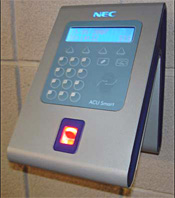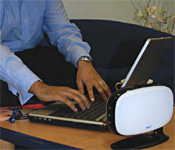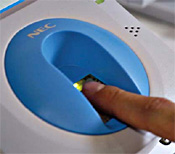
 |
Technology evolution occurs for different reasons, for example, to meet desired need or simply to push boundaries. Yet regardless of the origins of innovation, technology plays a monumental role in shaping people’s lives.
Here Derek Owen, General Manager, Marketing, from NEC outlines some of the crucial technologies expected to make a big impact in the near future. Indeed, some of these are already in action around the world.
Biometrics: the future of security
From airports to offices, schools to hospitals; biometrics technology is slowly
becoming ubiquitous. Its rise in popularity is down to one simple reason: in terms of providing secure ID checks for businesses and public sector organisations alike, biometrics works.
So what exactly do we mean by the term ‘biometrics’? There are many technologies that fall under this umbrella phrase and they have one thing in common: in one way or another they measure a biometric – be it a finger print or an iris scan – and compare it to existing records to prove the identity of the person in question.
The most familiar of all the biometric technologies is fingerprint recognition, which uses ultrasonic technology to emulate the traditional police method of matching fingerprints. Often used for access to laptops, buildings and secure areas, it is relatively cheap to install and easy to use. For example, NEC’s system uses a physical fingerprint authentication unit, which remembers your fingerprint data and is inserted into the PC card slot. To use it, workers simply place their finger over the touch sensor area on the card to bio-verify their identity and unlock the workstation.
Retina scanning is also becoming well known. Biometric retina technologies analyse the blood vessels using a low-intensity retina scan to map the unique patterns of the retina. The results of the scan are converted to computer code and stored in a database for authentication. Advocates of maintain that its error rate is only one in a million, making it the most accurate of all biometric technologies, but the fact that people who wear glasses or contact lenses cannot use it, as well as the invasive nature of the technology, diminishes its popularity.
Iris recognition uses camera technology and subtle infra red illumination to create digital templates which provide mathematical representations of the iris. Rarely impeded by glasses or contact lenses, iris recognition is suitable for more users than any other biometric solution. One key advantage is the stability of its template: the iris only needs to be scanned once, and this will last a lifetime. A facial recognition system uses a digital still or a video image to authenticate identity by comparing selected facial features with a database image. Facial recognition technology is not currently in widespread use because it needs extra hardware and therefore requires a significant investment. However, it is seen by many a viable solution as not only does it work at distance, it is also intuitive and non-intrusive. It is generally accepted that facial recognition is the most effective method for biometric identification for the future.
The future, therefore, is looking very positive for biometrics. IDC estimates that European sales of biometric technologies is worth $3bn and identifies fingerprint scanning and facial scanning as two dominant form factors. Over the next few years more creative application of biometrics and, in turn an acceleration in its business gains, are likely to be seen.
Active CCTV: NEC’s Smart Catch
 |
real-time, alerting the appropriate security staff for effective, immediate and efficient response. Tailored, or scenario-based, packages are available for specific types of detection, including:
Crowd detection – detects crowd size and queue length to prevent overcrowding situations
Exit lane – detects people going the wrong way in single direction entrance or exit lanes
Human tailgating/piggybacking – detects multiple people tailgating or piggybacking on a single access card
Loitering – detects people or vehicles loitering near secure or high value areas
Perimeter intrusion – detects and tracks people, vehicles, or other object intrusions into secured areas
Removed objects – detects the removal of stationary objects
Stopped vehicle – detects vehicles stopped near sensitive areas for a prolonged period
Turnstile violation – detects people hopping over or crawling under an access gate
Unattended objects – detects objects such as packages, luggage, and carts that are left unattended for a specified period of time
Vehicle tailgating/piggybacking – detects multiple vehicles tailgating or piggybacking on a single access card
Beyond smart CCTV, police forces could go a step further and consider integrating face recognition technology, as another layer on top of smart CCTV. Whilst this is unlikely to become a reality in the UK in the near future, it is not a futuristic or unproven option. For example, NEC delivered an immigration control system to the Hong Kong immigration office that features the world’s first car passenger face identification system, using NEC’s NeoFace system. The system enables face identification of car passengers by way of a database check when vehicles pass through immigration control points between Hong Kong and mainland China, based on biometric information compiled as part of a national ID card scheme. The adoption of facial recognition in the UK is nowhere near the level in the Far East, however agencies and organisations are looking at facial recognition technology for ways of tackling issues such as duplicate checking and attribute matching where a photograph or camera image (still and video) is an integral part of identification. This has many potential applications across government agencies, policing, security & guarding, transportation and border control.
NEC’s Femtocell Solution
 |
annum in 2012 out of a total shipment volume of 36 million units and a market valuation of US$4.2billion.
Femtocell solutions will provide mobile operators with a practical and cost-effective platform for delivering Next Generation Services direct to the end-user, such as competitive voice calling and IPTV, all via a single in-home device. In addition to providing new revenue streams, operators who take advantage of femtocell technology will be well-positioned to differentiate their service offering in the face of increasing competition in the wider telecoms market.
Femtocells have the potential to support viral consumption of services and data and could play a crucial role in underpinning the explosive growth of mobile broadband usage. The latest consumer gadgets, such as the Apple iPhone, are driving previously unseen levels of mobile internet usage, and across the industry the use of USB HSDPA modems has really taken off, effectively competing with DSL in some markets. Both of these place huge capacity demands on operators’ networks, and because so much of that usage is at home, femtocells coupled with DSL could provide an alternative capacity resource.
NEC’s technology is already being used in the UK’s first full trial of femtocell technology with O2, and NEC is proactively leading the femtocell market with several further trials underway in Europe and the rest of the world. NEC provides a complete end-to-end femtocell solution for operator that includes the 3G Femtocell Access Point, Femtocell Gateway and Access Point Management System.
